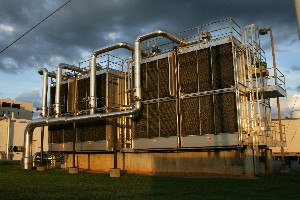A recent study by University of Pittsburgh researchers indicates that non-chemical water-treatment devices may not work as they claim and can allow dangerous bacteria to flourish in the cooling systems of hospitals and commercial offices, almost as much as they do in untreated water. The university says the study, conducted by its school of engineering, is the first to investigate the ability of non-chemical devices (NCDs) to control the growth of bacteria in water-based cooling systems.
The air systems investigated operate by piping chilled water throughout a building. The water warms as it exchanges temperature with the surrounding air and becomes a hotbed of microorganisms before returning to a central cooling tower to be cleaned and re-chilled. If the returning water is not thoroughly cleaned, bacteria can spread throughout the system, exposing people within the building to possible infection and hampering the system’s energy efficiency.
The team constructed two scale models of typical cooling towers. One model remained untreated while the other was treated with five commercially available NCDs installed according to the manufacturers’ guidelines. Each device was tested for four weeks.
The five devices tested represent different classes of NCDs:
- Pulsed electric-field devices emit electromagnetic energy that aim to rupture bacterial membranes and activate particles that ensnare the bacteria.
- Electrostatic devices function similarly by producing a constant static field.
- Ultrasonic devices pass a mixture of untreated water and high-pressure air through a chamber that intends to disintegrate bacteria with sound waves.
- Hydrodynamic cavitation devices, where two cone-shaped water streams collide to form a vacuum region filled with high-friction bubbles that collide with and presumably deactivate the bacteria.
- Magnetic devices, which are intended to prevent mineral buildup, not control bacterial growth.
The tests measured bacterial populations expressed in density of living cells (colony-forming unit, or CFU) per square centimeter. With all five types of devices, the water treated in the model cooling tower showed no significant difference in bacteria population than the non-treated tower during one month of side-by-side operation.
Chlorine was also administered three times during the study to demonstrate that an industry-accepted chemical treatment could kill bacteria even in a heavily contaminated system. After a chlorine treatment was administered, the microbial populations in both model cooling towers fell by four orders of magnitude within three days.
* * *


 RSS - Posts
RSS - Posts
[…] This post was mentioned on Twitter by Alltop Science, Alan Kotok. Alan Kotok said: 'Green' Treatments Fail to Stop Bacteria in Commercial A/C | #Science #Business http://t.co/AbfvhpA #ScienceBusiness […]
[…] Read more: ‘Green’ Treatments Fail to Stop Bacteria in Commercial A/C […]